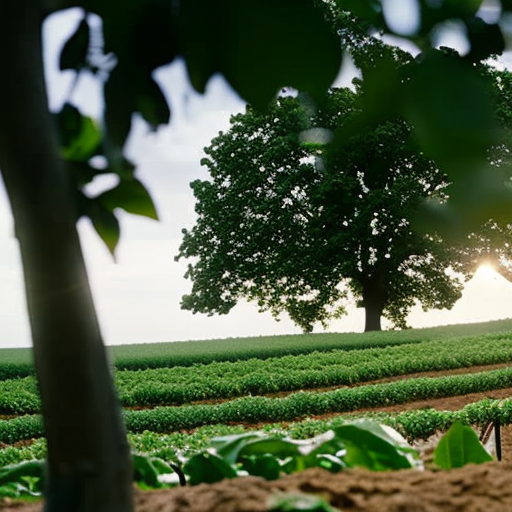
Climate-Focused Agroforestry Efforts and the Sustainable Development Goals

Despite their potential as a low-cost and immediately available natural climate solution, climate-focused agroforestry efforts are currently under-leveraged. This is largely due to ambiguity about which agroforestry actions provide carbon mitigation, alongside uncertainty as to their full sequestration potential, and difficulty in tracking the progress of agroforestry practices.
The Diversity of Agroforestry
Agroforestry comes in many different forms, including a variety of Indigenous, traditional, and modern farming practices—from ancient Roman farmers interlacing their fields with olive trees, to communities in the Amazon Basin combining forest stewardship with small-scale production of lucrative tropical crops like cacao and coffee.
“This diversity brings both benefits and challenges,” said senior author Susan Cook-Patton, a Senior Forest Restoration Scientist at TNC. “While this vast menu of options means farmers can more easily find an agroforestry system that will work for them, it also challenges scientists’ ability to determine how much climate mitigation any given system will offer.”
Identifying Science Gaps
To help achieve the best climate outcomes, the collaborators behind this study came together to identify the critical science gaps currently impeding the deployment of agroforestry practices at scale. The resulting review had three key findings:
- There is a lack of understanding around how much carbon an individual agroforestry system can hold and how that varies from farm to farm, even with the best-available estimates from organizations like the UN Intergovernmental Panel on Climate Change (IPCC).
- Existing maps overlook some of the most carbon-rich agroforestry systems in the world, indicating a lack of knowledge about where agroforestry currently occurs.
- Agroforestry adoption and ambition are not distributed equally across the world, with certain African countries leading global agroforestry efforts while other regions, particularly the Global North, have room for expansion given the right incentives.
“In many regions, trees have been increasingly removed from farms, especially in the Global North,” said co-author Rémi Cardinael, a researcher at CIRAD. “Agroforestry could be a smarter way to restore forest to these regions, compared with large scale reforestation projects that may be more vulnerable to disturbance, while also offering more direct benefits to farmers.”
Farmer-Focused Steps for Climate Mitigation
The researchers advocate for farmer-focused steps to accelerate investment in agroforestry for climate mitigation, while also enhancing the resilience and sustainability of food systems worldwide. In an effort to improve existing measurements on the potential of agroforestry, the researchers are now working to consolidate the information that already exists across thousands of often hard-to-access scientific papers.
“With the world’s land increasingly squeezed by competing demands for food, fiber, and fuel, we need to both produce more food and reduce carbon emissions,” said Fred Stolle, deputy director of the Forests program at World Resources Institute and another co-author on the paper. “Agroforestry is a critical way we can meet both goals at once.”
SDGs, Targets, and Indicators
| SDGs | Targets | Indicators |
|---|---|---|
| SDG 13: Climate Action | Target 13.2: Integrate climate change measures into national policies, strategies, and planning | Indicator not mentioned in the article |
| SDG 15: Life on Land | Target 15.1: Ensure the conservation, restoration, and sustainable use of terrestrial and inland freshwater ecosystems | Indicator not mentioned in the article |
| SDG 2: Zero Hunger | Target 2.4: Ensure sustainable food production systems and implement resilient agricultural practices | Indicator not mentioned in the article |
| SDG 1: No Poverty | Target 1.4: Ensure that all men and women have equal rights to economic resources, as well as access to basic services, ownership, and control over land and other forms of property | Indicator not mentioned in the article |
1. Which SDGs are addressed or connected to the issues highlighted in the article?
The SDGs that are addressed or connected to the issues highlighted in the article are SDG 13: Climate Action, SDG 15: Life on Land, SDG 2: Zero Hunger, and SDG 1: No Poverty.
2. What specific targets under those SDGs can be identified based on the article’s content?
Based on the article’s content, the specific targets that can be identified are:
– Target 13.2: Integrate climate change measures into national policies, strategies, and planning (under SDG 13: Climate Action)
– Target 15.1: Ensure the conservation, restoration, and sustainable use of terrestrial and inland freshwater ecosystems (under SDG 15: Life on Land)
– Target 2.4: Ensure sustainable food production systems and implement resilient agricultural practices (under SDG 2: Zero Hunger)
– Target 1.4: Ensure that all men and women have equal rights to economic resources, as well as access to basic services, ownership, and control over land and other forms of property (under SDG 1: No Poverty)
3. Are there any indicators mentioned or implied in the article that can be used to measure progress towards the identified targets?
No indicators are mentioned or implied in the article that can be used to measure progress towards the identified targets.
Note: The lack of specific indicators mentioned in the article does not mean that there are no indicators available to measure progress towards the identified targets. It simply means that the article does not provide information on such indicators.
Behold! This splendid article springs forth from the wellspring of knowledge, shaped by a wondrous proprietary AI technology that delved into a vast ocean of data, illuminating the path towards the Sustainable Development Goals. Remember that all rights are reserved by SDG Investors LLC, empowering us to champion progress together.
Source: nature.org

Join us, as fellow seekers of change, on a transformative journey at https://sdgtalks.ai/welcome, where you can become a member and actively contribute to shaping a brighter future.





